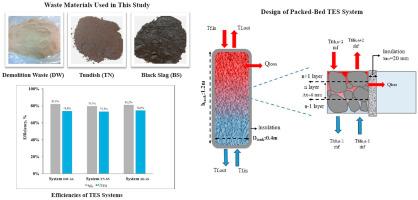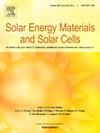使用三种不同废料的熔盐填料床热能储存系统的性能分析
IF 6.3
2区 材料科学
Q2 ENERGY & FUELS
引用次数: 0
摘要
聚光太阳能发电(CSP)是可再生能源转型的关键技术,可在高温条件下提供高功率输出。然而,进一步整合 CSP 发电厂需要降低投资成本。本研究探讨了如何利用具有成本效益、可持续发展的废料型热电解质系统材料--如钢铁工业中的电弧炉黑渣(BS)和钢渣(TN),以及城市改造项目中的拆除废料(DW)--作为热电解质系统的填料,以降低 CSP 电站的资本支出。采用一维连续固相(1D-2P)模型对 DW、TN 和 BS 的性能进行了评估和比较。结果表明,所有材料的性能相当,其中 TN 的储能容量(44.7 kWh)和储能密度(296 kWh/m³)最高。基于废物的 TES 系统具有 73-75% 的高利用率,显示出在 CSP 工厂应用的巨大潜力。这些 TES 系统是为一个 110 兆瓦的 CSP 电站设计的,该电站目前使用的是一个双罐熔盐 TES 系统,可提供 4648.4 兆瓦时的储能。对于 110 兆瓦的 CSP 发电站,TN 需要最小的存储容量(22273 立方米)。在基于废物的填料床 TES 系统中,熔盐用量最多可减少 31,000 吨,这将大大提高 CSP 电站的经济可行性。本文章由计算机程序翻译,如有差异,请以英文原文为准。

Performance analysis of a molten salt packed-bed thermal energy storage system using three different waste materials
Concentrated Solar Power (CSP) is a critical technology for the renewable energy transition, offering high power output at elevated temperatures. However, further integration of CSP plants requires a reduction in investment costs. This study investigates the use of cost-effective, sustainable, waste-based TES materials—such as Electric Arc Furnace Black Slag (BS) and Tundish (TN) from the steel industry, as well as Demolition Waste (DW) from urban regeneration projects—as packing materials in TES systems to reduce the capital expenditure of CSP plants. A One-Dimensional Continuous Solid Phase (1D-2P) model was employed to evaluate and compare the performance of DW, TN, and BS. The results revealed that all materials demonstrated comparable properties, with TN exhibiting the highest energy storage capacity (44.7 kWh) and energy storage density (296 kWh/m³). With high utilization rates of 73–75 %, waste-based TES systems show strong potential for application in CSP plants. The TES systems were scaled for a 110 MW CSP plant, which currently operates with a 2-tank molten salt TES system providing 4648.4 MWh of storage capacity. TN required the smallest storage volume of 22,273 m³ for the 110 MW CSP plant. The reduction of molten salt usage by up to 31,000 tons in the waste-based packed-bed TES system could significantly enhance the economic feasibility of CSP plants.
求助全文
通过发布文献求助,成功后即可免费获取论文全文。
去求助
来源期刊

Solar Energy Materials and Solar Cells
工程技术-材料科学:综合
CiteScore
12.60
自引率
11.60%
发文量
513
审稿时长
47 days
期刊介绍:
Solar Energy Materials & Solar Cells is intended as a vehicle for the dissemination of research results on materials science and technology related to photovoltaic, photothermal and photoelectrochemical solar energy conversion. Materials science is taken in the broadest possible sense and encompasses physics, chemistry, optics, materials fabrication and analysis for all types of materials.
 求助内容:
求助内容: 应助结果提醒方式:
应助结果提醒方式:


